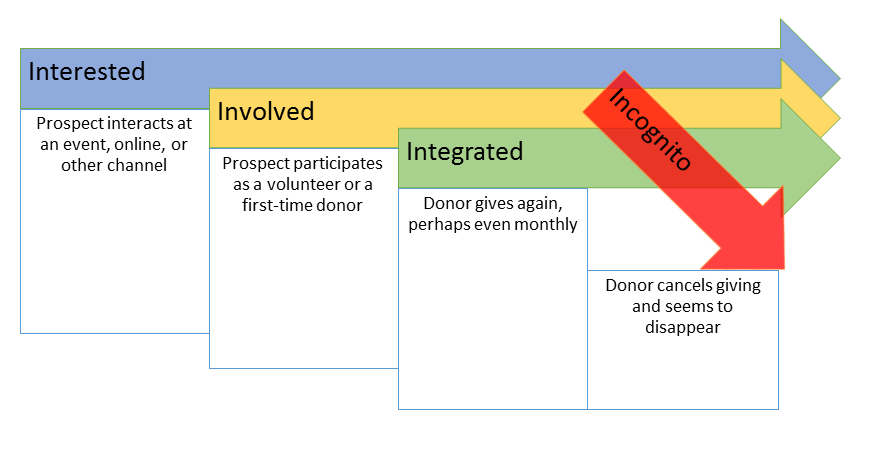Prevent Donor Loss With a Multi-Pronged Email Campaign
One of the major hindrances to nonprofit fundraising growth is donor churn.
You’re always adding new donors through events, auctions, social media, and other marketing efforts. But all the while, a few of your loyal donors stop giving each month.
Here’s the ‘Four-I’ donor loss process you need to interrupt: 
What went wrong?
What makes someone give, and then decide to stop a few months later?
This is called donor loss.
This is important to think about, because most people don’t give without an emotional motive. People care. Anyone who gives – no matter how little – cares about your work.
Thus, when someone stops giving, something about their emotional investment in your work must have diminished (unless their financial situation changed).
Donor Retention is Our Job – A Top Priority
It is our job as nonprofit marketers to keep our existing donors excited, passionate, and full of confidence that their gifts are making a profound difference.
How do we do that? With Email!
Think of your outreach efforts like a fork with at least five prongs:
- Email campaigns
- Social media
- Direct mail
- Events
- Website
- Other outreach methods (yes, this is a big fork).
But of these, email remains the best method to keep large numbers of donors integrated in your work for low cost. All are important, but email accomplishes things the others cannot.
Social media doesn’t consistently reach as many people as email, and it’s not as in-depth a forum. It also tends to be more immediate. If people aren’t logged in when you post, they might never see it.
Direct mail has higher costs. Events are isolated. And websites work best as a destination people arrive at when prompted through other means. Like email.
Here are a few things you can do best through email marketing:
- Send targeted emails. This is a great technique, especially with first-time donors because it lets them know they matter to you. That first month is when they’re most excited about your charity. You need to capitalize on it! You can create an email series that uniquely speaks to people who just gave in the last month, as well as even more specific criteria such as age and location.
- Tell up-to-the-minute stories from the field. Give them something specific to latch onto that has real emotion, and real impact. This confirms to them your work is active and effective.
- Run short surveys and polls. This accomplishes three goals: It communicates that you care about your donors’ opinions. It keeps them actively engaged. It gives you more information about them. You cannot know too much about your donors.
- Launch new fundraising and outreach campaigns. This works best for specific needs, not just general requests for funds. Tell readers you need a set amount of funds for a very distinct need, and motivate them to help reach the goal. People like to see results. (Caution – always be honest. Do not say you got a matching grant if you didn’t. Don’t say you have a goal to meet if it’s really just for the general fund. Don’t say 100% of donations go to a particular cause when they don’t. Eventually, someone will find out, and then your credibility is blown for years).
- Publicize upcoming events. Leverage your supporters and use them to help spread the word about your events. You can even use incentives like group discounts or prizes for supporters who recruit the most people.
- Introduce your staff and volunteers. Supporters feel a greater connection when they know you. Give your team members a little spotlight. Have them do a quick interview, or tell a story of something that impacted them.
Don’t Forget the Purpose of Email
In all these cases – keep in mind the function of the email. If you miss this, your emails will become like spam, and your donors are on the way to incognito.
Every single email must have a link to a page on your website. The email’s purpose is to introduce something. To initiate. To intrigue. The email is not meant to complete transactions.
Looking at the list up above, let’s apply this philosophy to each item.
-Stories? Give the introduction, but have a link to see the rest on the website.
-Events? Have a link to the page with more information and the signup form.
-Asking for funds? Include a donate button that links to the donation page on the website.
Whatever the email is doing, it should not be doing it alone. This is because people don’t expect to close anything in emails. This isn’t a random rule we have to follow. It’s how people already think about email.
When you create a complete email marketing strategy, your donors will feel more connected, interested, valued, and respected. They will become advocates. They will become long-term supporters.
And if you like hard numbers, think of it this way:
If all your marketing efforts bring in $100,000 in new donations for a year, but you lose $75,000 from donors who stop giving, then you are expending a ton of effort and not getting much for it.
On the other hand, if you can retain a majority of your donors and bring in new ones, now you’ll start to see real growth.
A Note about Social Media
Social media is often touted as superior to email. But social media is merely another avenue for some of these same techniques. You can do polls, share stories and video clips, and publicize events much like you can in email.
But this is not an either/or. It’s a both/and. Social media works well with some audiences, and email works well with others. But the conversion rates attributed to email are much higher than social media, and the main reason is simple – almost everyone checks their email regularly.
But a good percentage of people do not do this with social media. And, there are so many other distractions on social media that it’s harder to pull in your supporters. They will miss stuff you post.
On email, once they’re reading your message, that’s all they’re doing. It’s a more focused and direct form of communication.
But they do need to open it, and for that – you need a good subject line. But that’s a topic for another article.
If you’ve run a few email campaigns and haven’t been happy with the results, or don’t know how to collect data on open-rates and click-throughs (whether people click the links in your email), get in touch with me and I’ll take a look at your situation and suggest some ways to improve.


